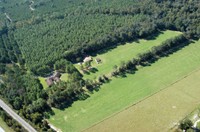Family Forests Are the Ties That Bind the Landscape
Family forests have an enormous capacity to provide ecosystem services such as clean air and water, timber and nontimber forest products, wildlife habitat, and scenic beauty and recreation — benefits that stretch far beyond property lines. Research demonstrates that sustaining these services depends on not only the condition of individual family forests but also the characteristics of bordering lands.
 An Eastern Forest Environmental Threat
Assessment Center researcher and North Carolina State University collaborator assessed the threats
to family forests in the lower 48 States by measuring changes in the landscape
around them between 2001 and 2011, focusing on changes in forest fragmentation
and human interface zones. Their findings, published in the journal Landscape and Urban Planning, indicate
that landscapes containing family forests exhibited substantial changes over a
relatively short period of time. By 2011, 46 percent of family forest land area
was in a human interface zone, including 33 percent in agricultural interface
zones which have been linked to fire occurrence and the spread of invasive
plants. While only 29 percent of family forest area was considered unfragmented
in 2011, most of the total unfragmented forest was still privately owned
because most forest area is privately owned. The study identified broad areas
where conservation of family forests could be targeted and leveraged to achieve
far-reaching impacts. These areas include the eastern Great Plains steppe and
parkland, Midwest broadleaf forest, and California coast, where unfragmented
forest is relatively rare, as well as most of the eastern United States, where
family forests dominate the landscape.
An Eastern Forest Environmental Threat
Assessment Center researcher and North Carolina State University collaborator assessed the threats
to family forests in the lower 48 States by measuring changes in the landscape
around them between 2001 and 2011, focusing on changes in forest fragmentation
and human interface zones. Their findings, published in the journal Landscape and Urban Planning, indicate
that landscapes containing family forests exhibited substantial changes over a
relatively short period of time. By 2011, 46 percent of family forest land area
was in a human interface zone, including 33 percent in agricultural interface
zones which have been linked to fire occurrence and the spread of invasive
plants. While only 29 percent of family forest area was considered unfragmented
in 2011, most of the total unfragmented forest was still privately owned
because most forest area is privately owned. The study identified broad areas
where conservation of family forests could be targeted and leveraged to achieve
far-reaching impacts. These areas include the eastern Great Plains steppe and
parkland, Midwest broadleaf forest, and California coast, where unfragmented
forest is relatively rare, as well as most of the eastern United States, where
family forests dominate the landscape.
Pictured: Exurban development changes the landscape context of family forest. Photo by Larry Korhnak, Interface South.
Related publications:
External Partners/Collaborators: North Carolina State University
Contact: Kurt Riitters, Research Ecologist, kurt.h.riitters@usda.gov



